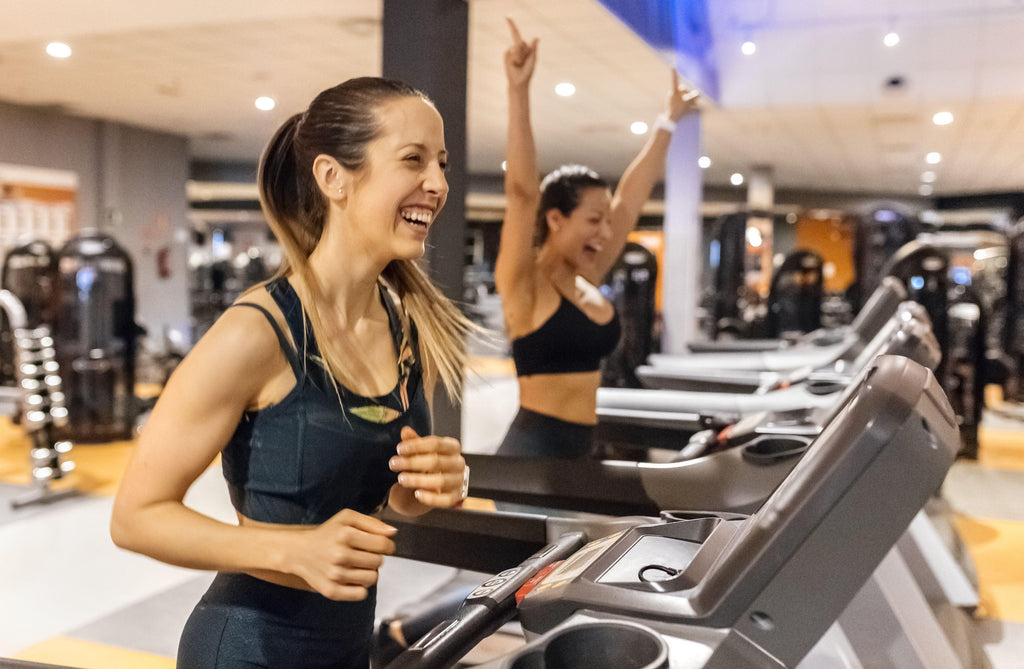Part 3: Engage in Regular Exercise
I’m certain that the title of this third installment of my 5-part series “5 Things You Must Do To Avoid An Early Death” caused many an eye to roll.
Exercise probably comes in fourth on the list of things that people dread the most, right after public speaking, snakes and spiders.
Regardless of your level of affinity (or loathing) for exercise, the fact remains that it is crucial to achieving optimal health, preventing disease and maintaining a healthy bodyweight for life.
Ain’t no magic pill in the world that’s going to do that for you, my friend.
But the good news is exercise does not have to be drudgery! It can truly be something you enjoy and from which you will certainly reap incredible health benefits.
Here’s what I mean.
The impressive benefits of regular exercise
Over and above the obvious weight loss or maintenance, here are some of the ways that working up a sweat is a smart health move:
1- A boost for your heart and vessels[[end[[
Exercise improves your circulation and strengthens all of your muscles, including your heart. This can help lower your blood pressure, cholesterol and triglycerides, and help prevent against heart attack and stroke.
2- Ease joint pain
The stronger the muscles are around your joints, the more pressure they take off your joints, which can help ease pain, stiffness and inflammation.
3- Turn on your inner vacuum
Your lymphatic system is your body’s "inner vacuum." It’s an amazing filtration system designed to pull out and expel wastes surrounding your cells. One of the ways it “takes out your inner trash” is through your sweat.
So if you are a person that avoids exercise because you don’t like to sweat, you may be accumulating excess cell wastes. This can cause body odor as well as make you a very attractive home for sickness and disease to flourish.
Unlike your circulatory system, your lymphatic system doesn’t have a “pump” (like your heart) to keep lymph flowing around your cells. Instead you must be the pump with regular exercise.
4- Counteract depression
Exercise encourages the release of your body’s feel-good chemicals (neurotransmitters and endorphins) and naturally helps counteract depression.
In addition, exercise lowers inflammation in your body. Chronic inflammation is closely linked to depression, so exercise helps from that angle as well.
And recent studies have even shown that regular exercise is more effective than medication in the treatment of depression and anxiety!
Working out also helps prevent anxiety and depression.
5- Stress relief
Exercise is one of the most effective stress-relievers in existence.
Stress is an underlying factor in virtually all sickness and disease because it hampers your immune system functioning.
In addition, stress causes poor sleep, and lacking sleep also weakens your immune system.
6- Prevent diabetes
When you exercise, your body burns glycogen, which is a form of glucose that is stored in your muscles. After exercise, your muscles replenish their glycogen supply with glucose from your bloodstream.
The more glycogen that you burn during exercise, the more glucose your muscles will need to pull from the bloodstream afterward.
This can eventually improve insulin sensitivity in the cells and lower your risk of Type 2 diabetes since there will be less glucose in your bloodstream that your cells will be “pushed” to absorb by the hormone insulin.
Simple steps to your exercise success
Regardless of where you may be starting from, you can successfully carry out and enjoy an exercise regimen. The important thing is to be safe and smart and avoid common pitfalls.
Here are four steps that will help ensure your success:
Step 1. Get your doctor’s approval
Very few people are completely physically unable to exercise; most of us can at least tolerate an activity such as walking, biking or using free weights. However, it is important to see a doctor and have him or her clear you for exercise, especially if you have never exercised, haven’t done so in quite a while, or are pursuing an activity that you have never done before.
It is also important to get a doctor’s OK if you:
- Have a known heart condition or have had a stroke
- Have chest pain, particularly on exertion
- Have fallen due to dizziness or blacking out
- Become breathless on mild exertion
- Have a joint or back problem
- Are pregnant
Step 2. Pick the right activity
Generally speaking, you should choose an activity that you like, that interests you or at least that you will not dread. Here are some points to consider:
Here are some questions to help determine what form(s) of exercise will work best for you:
Do you prefer exercising by yourself or with others? If you would rather be alone, then running, walking, swimming, free weights or DVDs are good choices. If you like being with others, a class or gym setting may be for you.
Do you enjoy being outdoors? Some people love outdoor activities (weather permitting) such as running, walking, gardening or yard work.
Do you like activities that involve contact (soccer, basketball, martial arts, dancing)? Choose activities that do not involve contact if you are not comfortable in close contact with others.
Do you prefer to compete with others, or not compete at all? Some people enjoy competition, while others fare better without it. Avoid activities such as team sports or tennis if you dislike competition.
When do you prefer to exercise? The options that are available to you are influenced by the time you like to work out. Most gyms are open early morning to later evening. If you like midday activities, a brisk walk or a stretching class on your lunch hour are good choices.
Step 3. Take it step by step
There are many opinions about the number of times per week that people should exercise and the duration of their workouts.
I will start by saying that ANY exercise is better than none at all! However, you should initially be aiming for at least 150 minutes of moderate to vigorous exercise each week, broken down into three or four different sessions.
To assess where you may stand, here are my five different categories of exercisers-in-the-making and helpful hints for each:
Category #1: Exercise? What’s exercise?
This is you if you have either never done any appreciable form of exercise or have not worked out in any meaningful way since your youth.
Helpful hints: Start with 30 minutes of exercise three times per week and build up as your strength and stamina increase. Brisk walking is a good activity to start with, as just about everyone can do it and the risk of injury is minimal.
Category #2: I’m so busy—I get plenty of exercise all day!
In this category you equate activity with exercise. You may be chasing the kids all day, taking care of the house or running errands, but activity is not the same as exercise.
Helpful hints: Exercise involves continuous movement that raises your heart rate for a period of time (at least 30 minutes) and ideally causes you to sweat. Carve out 30 minutes for exercise at least three days per week and increase from there.
Category #3: I want to exercise, but I have doubts or fears.
You are in this category if you have doubts or fears—about your physical capabilities, getting injured, how you look in workout clothes, whether you will be good at it, looking foolish, being uncoordinated, etc.
Helpful hints: Getting your doctor’s OK beforehand should confirm that you are healthy enough for exercise. Warm up and stretch prior to a workout to minimize the chances of injury and stick to lower impact activities until you build your strength and confidence.
If you feel self-conscious or doubt your abilities, work out in the privacy of your home.
Category #4: I try to exercise, but then I just quit.
This would describe you if you have had a history of trying various forms of exercise but never really sticking to anything.
Helpful hints: If you are in this category, first you need to stop “trying” to exercise—instead commit to doing it! As Master Yoda said, “Do or do not. There is no try.”
It’s especially important to select an activity that you like—that way you will be more likely to stick to it. Pay close attention to your progress and note how good you feel after working out.
Category #5: I exercise but I’m in a rut.
You may be in this category if you have done the same form of exercise for a long time and have not switched it up or increased it in any way.
Helpful hints: While you should be commended for getting some exercise, it is time to shake up your routine. This can be done a few different ways—either increase your workout time (such as from 30 to 45 minutes, or 45 minutes to an hour), add another day per week to your regimen, or take on a new activity in addition to what you already do.
General tips for your success
No matter what your exercise situation is, here are some general tips to help pave the way for your success:
Step 4. Stay motivated
Here are some strategies you can use to help stay on track and keep your motivation level high:
Track your progress and celebrate your little victories along the way. It is much easier to stay motivated when you look back and see how far you’ve come and how you’ve improved.
Get a buddy. You are far less likely to skip a workout if you have someone counting on you to show up.
Make your goals challenging but realistic. If you start by running two miles, don’t expect to suddenly run a half-marathon. Graduate to a 5K, then maybe five miles, and work your way up with more reasonable goals in between.
Make the time. Remember that we have the time for whatever we make the time for. Make the time for exercise.
Join a class. Classes can be a lot of fun and when you are having fun, you will find yourself looking forward to your workouts instead of dreading them.
Listen to upbeat, motivating music. Create a high-energy playlist of music you like.
Watch TV. Put a TV set in your home workout area.
Consider a personal trainer. Having to be accountable to someone else can increase your motivation to stick to your fitness routine.
It’s time for you to get on the exercise bandwagon NOW. No more excuses! See all the wonderful things that regular exercise can do for you….and you’ll probably live longer as a result!
You can do it, you deserve it, and I am rooting for you!
To your health,
Sherry Brescia
PS: I walk my talk here, my friend. At age 60 and as a 4th degree blackbelt in karate, after 19 years of training I have changed martial arts disciplines and am now working towards a new blackbelt in mixed martial arts.











